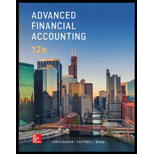
a
Introduction: When an affiliate of the issuer later acquires bonds from an unrelated party, the bonds are retired at the time of purchase. The bonds are not held outside the consolidated entity once another company within the consolidated entity purchases them, it must be treated as repurchase by the debtor. The acquisition of an affiliate’s bonds by another company within affiliated entities is referred to as constructive retirement. Although bonds are not actually retired.
When constructive retirement occurs the consolidated income statement reports gain or loss based on the difference between carrying value and purchase price paid by the affiliate to acquire it. And it is not reported in the consolidated
The worksheet consolidation entries as of December 31, 20X4, to complete consolidated balance sheet worksheet assuming S earned $74,476 and paid $10,000 in dividends during the year.
b
Introduction: When an affiliate of the issuer later acquires bonds from an unrelated party, the bonds are retired at the time of purchase. The bonds are not held outside the consolidated entity once another company within the consolidated entity purchases them, it must be treated as repurchase by the debtor. The acquisition of an affiliate’s bonds by another company within affiliated entities is referred to as constructive retirement. Although bonds are not actually retired.
When constructive retirement occurs the consolidated income statement reports gain or loss based on the difference between carrying value and purchase price paid by the affiliate to acquire it. And it is not reported in the consolidated balance sheet either as bond payable or as an investment because the bonds are no longer outstanding.
The preparation of consolidation worksheet for 20X4
c
Introduction: When an affiliate of the issuer later acquires bonds from an unrelated party, the bonds are retired at the time of purchase. The bonds are not held outside the consolidated entity once another company within the consolidated entity purchases them, it must be treated as repurchase by the debtor. The acquisition of an affiliate’s bonds by another company within affiliated entities is referred to as constructive retirement. Although bonds are not actually retired.
When constructive retirement occurs the consolidated income statement reports gain or loss based on the difference between carrying value and purchase price paid by the affiliate to acquire it. And it is not reported in the consolidated balance sheet either as bond payable or as an investment because the bonds are no longer outstanding.
The preparation of consolidation worksheet for 20X4
Want to see the full answer?
Check out a sample textbook solution
Chapter 8 Solutions
Advanced Financial Accounting
- Please provide the solution to this general accounting question with accurate financial calculations.arrow_forwardCan you help me solve this general accounting problem using the correct accounting process?arrow_forwardI need assistance with this general accounting question using appropriate principles.arrow_forward
- Please provide the accurate answer to this financial accounting problem using valid techniques.arrow_forwardBased on this information the cost that would be allocated to the land is ___.arrow_forwardI am looking for help with this general accounting question using proper accounting standards.arrow_forward

 AccountingAccountingISBN:9781337272094Author:WARREN, Carl S., Reeve, James M., Duchac, Jonathan E.Publisher:Cengage Learning,
AccountingAccountingISBN:9781337272094Author:WARREN, Carl S., Reeve, James M., Duchac, Jonathan E.Publisher:Cengage Learning, Accounting Information SystemsAccountingISBN:9781337619202Author:Hall, James A.Publisher:Cengage Learning,
Accounting Information SystemsAccountingISBN:9781337619202Author:Hall, James A.Publisher:Cengage Learning, Horngren's Cost Accounting: A Managerial Emphasis...AccountingISBN:9780134475585Author:Srikant M. Datar, Madhav V. RajanPublisher:PEARSON
Horngren's Cost Accounting: A Managerial Emphasis...AccountingISBN:9780134475585Author:Srikant M. Datar, Madhav V. RajanPublisher:PEARSON Intermediate AccountingAccountingISBN:9781259722660Author:J. David Spiceland, Mark W. Nelson, Wayne M ThomasPublisher:McGraw-Hill Education
Intermediate AccountingAccountingISBN:9781259722660Author:J. David Spiceland, Mark W. Nelson, Wayne M ThomasPublisher:McGraw-Hill Education Financial and Managerial AccountingAccountingISBN:9781259726705Author:John J Wild, Ken W. Shaw, Barbara Chiappetta Fundamental Accounting PrinciplesPublisher:McGraw-Hill Education
Financial and Managerial AccountingAccountingISBN:9781259726705Author:John J Wild, Ken W. Shaw, Barbara Chiappetta Fundamental Accounting PrinciplesPublisher:McGraw-Hill Education





